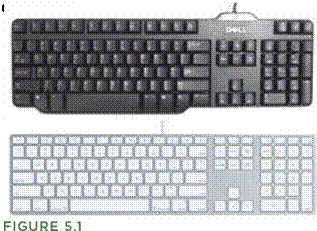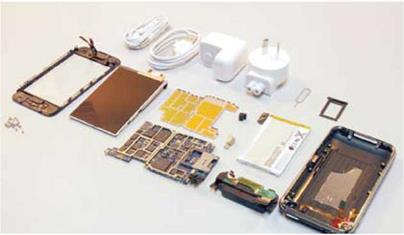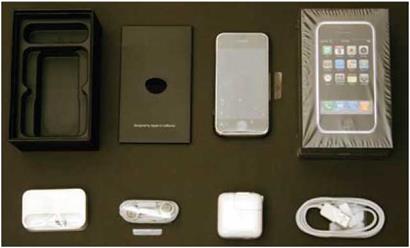 |
 |
Compare these two keyboards (see Figure 5.1). The first is a standard keyboard you would find with most computer systems. It uses a lot of material, most of which is plastic. The second is Apple’s new keyboard, which dematerial – izes the keyboard to a remarkable degree. Not only does it use less material overall, but it also uses less plastic (opting for aluminum instead, which is much more easily recycled). And it still performs all of the same functions.
Apple has become a master at dematerialization. In fact, Apple’s learned so much about the design, development, and manufacturing processes around this principle that it has become a core differentiator from its competition and has a sustainable competitive advantage. The iPhone is probably the best, though not only, example of this. However, the iPods and most everything Apple produces are also examples of sustainability (see Figure 5.2).
|
FIGURE 5.2. /И http://www. flickr. com/photos/rosenfeldmedia/3261613714 The iPhone’s parts are so carefully designed and tightly packed that there is no extra material to reduce. |
To begin, the iPhone has no wasted materials. It isn’t designed any bigger than it needs to be or with parts that are used strictly for ornamentation and serving no purpose. It’s as small as its components—and the human hand—will allow. In fact, it’s nearly a miracle of contemporary engineering. If you were to take one apart, you would be hard-pressed to find any material you could suggest to eliminate—even a bit. This is extraordinary. However, it’s neither an accident nor a fluke. All of Apple’s products are similarly dematerialized, although the mobile products tend to be to the greatest degree. Apple’s desktop computers, like the iMac and Mac Mini, it’s accessories, like its Airport base station, and even its keyboards, use materials more efficiently than all of Apple’s competitors’ products. To be sure, Apple isn’t sacrificing performance with this focus. Its products are some of the most high quality and most technically capable in the industry.
Even Apple’s packaging has been dematerialized to the extreme and well beyond most of its competitors (see Figure 5.3).
|
FIGURE 5.3. /И http://www. flickr. com/photos/rosenfeldmedia/3261609618 Apple dematerializes everything, including packaging. |
So how is Apple doing it? The first answer is commitment. Though it’s not usually discussed publicly (for fear of castigation or reprisals by environmental groups), dematerialization and material substitution (see Chapter 6) are design directives throughout the company. In addition, this focus extends to the choice of material, not just the amount of material. Apple has moved to aluminum enclosures throughout most of its products. While this material has a higher embodied energy than plastic (meaning, it takes more energy to produce overall giving it a higher impact on the environment), aluminum allows Apple to use less material in more structurally sound designs, which saves weight and bulk and increases the ability and likelihood that the parts will be recycled. (While all materials can be recycled, most plastics are in such low demand that they are effectively unrecyclable.)
Apple hasn’t stopped there, however. Apple has led the industry in dematerializing its packaging to an extraordinary degree, ending the often shameful waste of packaging for products like software. It isn’t perfect (there’s really no need to have a box to sell MobileMe Internet
 |
services), but it’s gone further than any company in the industry in terms of product design and dematerialization (see Figure 5.4).
Lastly, Apple’s iPods and iPhones (as well as some other phones and portable devices) also have the effect of dematerializing other products entirely. When you buy an iPhone, not only are you replacing your phone, but also your portable audio player, PDA (personal digital assistant),
and increasingly your watch, digital camera, GPS device, slide projectors (remember those?), and even television. This is dematerialization taken to the extreme, and it creates a much more beneficial impact than merely reducing the materials in a single product. [40] [41]
• Minimize the number and type of fasteners.
• Use materials and processes that require minimal manufacturing energy and materials.
• Use production methods that produce less waste and recycle any waste created.
• Use low-energy production methods and energy from renewable sources.
• Manufacture products closer to customers (requiring less transportation).
• Redesign manufacturing processes to raise quality standards and make quality control easier (so fewer defective products are made or enter the market, only to be returned).
• Develop products to be more useful, usable, and desirable.
Packaging
• Design lighter and smaller packaging. [42]
• Create packaging that doubles as promotional material.
• Design reusable packaging (either by customer or by manufacturer when returned).
• Create packaging that doubles as shipping packaging (such as integrated handles or places to put mailing labels so another shipping box isn’t required).
• Use materials and processes that require minimal manufacturing energy and materials.
• Create packages of bulk products or concentrated products (like concentrated liquid dishwashing soap or powered soaps).
• Design packaging for refilling rather than replacement. [43]





